
Gold mourning pendant with lock of hair on 18ct chain
A circular gold mourning pendant with lock of hair to reverse, suspended on an 18ct gold chain, 4.7 grams total
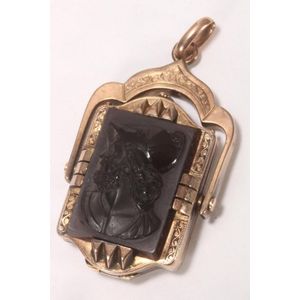
Victorian 14ct Gold Swivel Locket with Carnelian Warrior Cameo
Victorian 14ct gold swivel locket cameo, unmarked (tested 14ct), with cameo rectangular carnelian carving of a classical warrior (possibly Mars), on a shaped rectangular swivel, opening via hinge to two rectangular photo windows, in an arch shaped frame…

Victorian Jet Pendant with Carved Maiden and Old Photograph
Victorian jet pendant, oval shape carved jet with applied maiden with wine leaves in her hair with old photograph of a gentleman to interior

Antique Australian Silver Quandong Seed Photo Locket, Queensland Origin
An antique Australian silver mounted quandong seed photo locket, Queensland origin, 19th century, 3 cm high overall

19th Century Harvey Smith 9ct Rose Gold Waratah Photo Pendant
Harvey Smith antique 9ct rose gold photo pendant adorned with waratah motif, 19th century, stamped 'Harvey Smith, 9ct', 5.8 cm high overall, 28.4 grams total
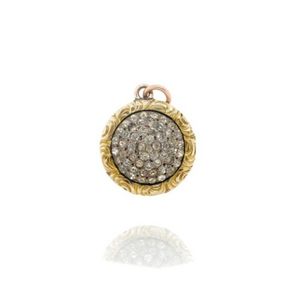
George IV Mourning Pendant with Engraving and Diamond Setting
George IV mourning pendant engraved Rg Sept 16 1824. Set with past, dia. 18.5 mm

Gold Bloodstone and Agate Mourning Fob Locket Pendant Engraved
9ct gold bloodstone and agate mourning fob pendant, combination locket and pendant with engraved foliate support

1910 Diamond and Yellow Metal Locket from Sydney Johnson Studio
Diamond and yellow metal locket C.1910 unmarked (likely of Australian make), weight 15.26 grams, item size 40 x 32 mm. Rose cut diamond size 2.6 mm * photo is marked the Johnson studio's 67 market street Sydney. William Johnson work in market street…

Antique Black Enamel Mourning Locket: 47 x 40 mm Size
Antique black enamel mourning locket approx size 47 x 40 mm
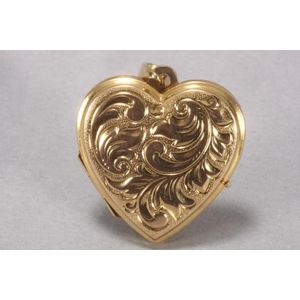
9ct Gold Heart Locket Pendant with Foliate Design, 3.58g
9ct gold heart locket pendant, stamped 375, of heart form with pressed foliate design to cover, opening to reveal two photo windows, total weight 3.58gm, drop 3.2 cm x width 2.5 cm

Antique 9ct Gold Oval Locket with Two Photo Portraits
An antique 9ct yellow gold oval locket with two black and white photo portraits, 19th century, 5 cm high overall, 19 grams total

Enamel and Seed Pearl Mourning Locket with Floral Motif
Enamel and seed pearl mourning locket, the hinged oval locket, centring a floral motif detailed with seed pearls, within a black and white enamel foliate surround, length 28 mm, width 22 mm.

Mourning Jewellery Collection: 1835 Hair Lockets and Cameo Pendant
Collection of mourning jewellery, including a brooch centring a glazed panel containing a locket of hair, the reverse inscribed 'Jg died August 6th 1835, in 9ct gold, a sardonyx cameo depicting a woman in profile, and a seed pearl and onyx pendant, glazed…

9ct Gold Miniature Mourning Pendant with Portrait of Gentleman
9ct gold miniature mourning pendant, the oval pendant with glazed front with a portrait of a gentleman, glazed panel to reverse containing hair, length 45 mm, width 38 mm, weight approximately 16.0 grams.

1802 Mourning Ring with Enamel and Hair Locket Compartment
9ct gold and enamel mourning ring, circa 1802, with central spinning panel with urn motif in black and white enamel reading 'John Vaisey Ob: 22 Oct 1802 Ae 62', the reverse containing a glazed compartment with a locket of hair, the inside shank inscribed…

Antique Australian Gold Pendant with Pearls, Sapphires, and Ruby
An antique Australian 9ct gold double-sided photo pendant, adorned with seed pearls, sapphires and a ruby, circa 1900, 4 cm high

1880 Gold and Diamond Photo Locket with Buckle Motif
Gold and diamond photo locket, circa 1880; the 15ct gold hinged oval locket centring an applied buckle motif accented with rose-cut diamonds, comprising two glazed photo compartments framed in 9ct gold to the interior, completed with an 18ct gold bail,…

Victorian Enamel Mourning Locket with Split Pearl and Wear
Victorian enamel mourning locket star set with a single split pearl. Approx size 40 x 30 mm. wear around the hinge. With a rose gold bail

Glasgow 1912 Rose Gold Locket with Print Photo
George V 9ct rose gold photo locket marked Glasgow 1912 Collins & co. Approx dia. 34 mm, weight 6.5 grams, photo is a print
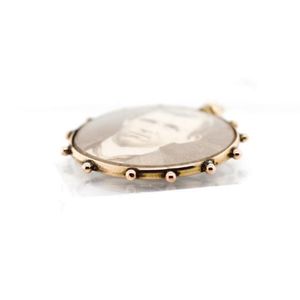
Vintage 9ct Rose Gold Photo Locket - 6g, 32mm
Antique 9ct rose gold photo locket marked 9ct. Approx total weight 6 grams, dia.32 mm, photo is a print

Victorian Turquoise Locket Pendant on Beaded Necklace
Victorian 14ct gold turquoise locket pendant, of oval form, with central oval convex plaque studded with many small turquoise half stones, within a 14ct gold surround accented with rope twist borders and eight bezel set cabochon cut turquoise stones, with…
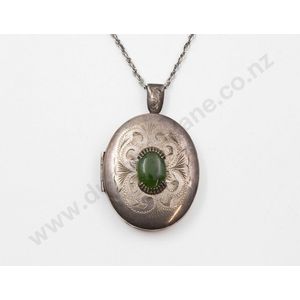
Greenstone Oval Locket: Sterling Silver Engraved Photo Pendant
Large sterling silver greenstone photo locket, bright cut engraved with oval greenstone panel stamped Kcl Stersil
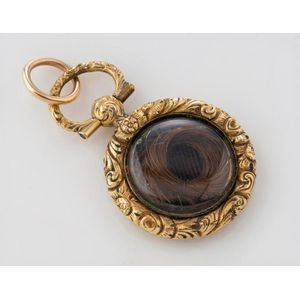
Antique Mourning Pendant with Hair Lock Window
An antique yellow gold and black enamel mourning pendant with hair lock window verso, 19th century, 3 cm high overall

Russian Enamel and Gem Locket with Gold Border
Russian 14ct gold, enamel and gem set locket, stamped 56 Zolotnik, maker Aw, of organic shaped form with gold c-scroll border and guilloche enamel cover, featuring a gem set foliate design to center with bezel set sapphire, ruby and emerald and small…

Victorian Rose Gold Double Sided Photo Locket
A Victorian 9ct rose gold double sided photo locket, faceted fine panelled frame with wishbone suspension and bale.

Victorian Rose Gold Carnelian Mourning Fob Pendant
A Victorian 9ct rose gold mourning fob pendant, set with carnelian. Hallmarked Whh, Birmingham, 1886. Weight 8.6g.

Double-Sided Circular Locket with Seed Pearls and Red Stones
Aronson & Co. Of Melbourne (attributed), beautiful double sided circular photo locket, 9ct yellow gold set with seed pearls and red stones, late 19th century, 5 cm high overall

Melbourne Colonial Gold Photo Pendant, Late 19th Century
An antique Colonial 9ct gold double sided photo pendant, Melbourne origin, late 19th century, 4 cm high overall, 2.7 grams total

Victorian 9ct Gold Locket with Double Portraits
Victorian 9ct gold sided photo locket, marked 9ct gold sided, maker W.O.D, of oval form with shield set to cover, opening to reveal double portraits of a young man and older woman, height 3.5 cm

Victorian Garnet and Pearl Mourning Pendant
9ct yellow gold Victorian mourning pendant, set with four 11 x 9 mm oval cabochon garnets and seed pearls. Total weight 13.62 grams. Overall size 58 x 24 mm.

Victorian Book Locket with Cameo and Photos
Victorian pinchbeck locket, book shape with two photo lockets and carved cameo
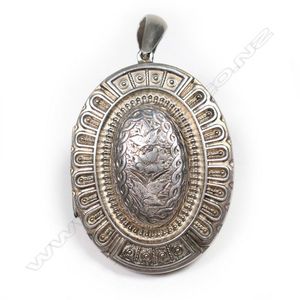
Victorian Silver Engraved Photo Locket with Beaded Border
Victorian silver fancy photo locket, engraved oval centre, bead and panelled border. 14.1 grams

Victorian Fleur de Lis Photo Locket
A Victorian silver ornate photo locket, engraved florals, the outer frame panelled with fleur de lis. Birmingham 1882.

Silver Monogrammed Photo Locket
An early 20th century silver hinged photo locket, applied monogrammed initials.

Victorian Gold Leaf Photo Pendant
A 9ct gold Victorian photo pendant, leaf frame, glazed front and back.

Edwardian Gold Locket with Seed Pearls and Rubies
An Edwardian 9ct gold, seed pearl and ruby photo locket, photos to both sides.

Antique Gold Child Locket Pendant Necklace
An antique gold miniature pendant necklace; locket set with an early photo of a child with guilloche locket compartment to rear to floral border and bale on a cable link chain, pendant tests approx. 4ct gold, size 80 x 50 mm, wt. 43.47g, chain tests 17ct…

Antique Foliage Locket in 18ct Gold
Pendant locket brooch an ornate locket with folate design and hinged cover. Circa 1860s\1870s. In 18ct yellow gold. Weight: 11.5 grams. Containing a photo..

Bright Cut Floral Engraved 9ct Circular Locket (2.2cm)
9ct circular photo locket bright cut floral engraved 2.2 cm diameter

WW1 Double Photo Locket, Yellow Gold, 9ct, Unmarked
WW1 Period yellow gold double photo locket unmarked. Misstruck mark Approx dia 30 mm, tests as 9ct

Victorian Black Enamel Mourning Locket with Chip
Victorian black enamel and metal mourning locket approx size 26 x 34 mm, chip to reverse corner

Victorian Enamel Mourning Locket with Gilt Metal - Damaged
Victorian enamel and gilt metal mourning locket, a chip to the enamel, size 26 x 33 mm, weight 15.9 grams total

Coach Heart Locket Keychain with Pink Enamel and Silver Tone
A Coach heart locket keychain. Pink enamel heart with slot for a photo inside. Silver tone hardware. Length 8.5 cm. Box.

Round 9ct Gold Locket with Inscription and Maker's Mark
Frank Grady 9ct gold photo locket, round form. Presentation inscribed. Stamped maker's mark.

Antique 9ct Gold Seed Pearl Locket (1900)
An antique 9ct gold and seed pearl photo locket, circa 1900, 2 cm high

Victorian 'Regard' Heart Locket Pendant
'Regard' Victorian 15ct locket, stunning heart shaped 'Regard' mourning drop pendant hinged locket with embossed reverse

Victorian Prince of Wales Feathers Mourning Pendant & Chain
A Victorian gold plated Prince of Wales feathers mourning pendant, on related plated chain.

Gold-Plated Double-Sided Photo Locket - 47mm Diameter
An Edwardian gold-plated double-sided photo locket. Diameter 47 mm.

Victorian Whitby Jet and Pearl Mourning Pendant in Gold
A Victorian Whitby jet and seed pearl mourning pendant, set in 14ct yellow gold. Weight 4.1g.

Assorted 9ct Gold Fobs and Lockets (5 items)
Various 9ct gold fobs, etc., comprising of a map of Australia, an A.N.A., a Freemason's set-square and compass, a hair-locket and a photo locket. Approx. 13gms total. (5 items).

Antique 15ct Gold Portrait Pendant with Seed Pearls
An antique 15ct gold photo portrait pendant set with seed pearls, late 19th century, 4.2 cm high

Victorian Onyx Diamond Photo Locket
Victorian onyx and single diamond photo locket plain oval form with scroll set old rose cut diamond

Antique Accessories Set: Watch, Cigarette Holder, Locket, Pen
Rivana antique 9ct gold lady's watch, cigarette holder with gold fittings in original leather case, gilt metal and enamel antique photo locket, silver pen (incomplete), 19th and early 20th century, (4 items),

WWI Mourning Brooch Pendant with Garnets and Pearls
World War I mourning brooch drop pendant, beautiful 9ct yellow gold flanked by facet cut garnets and seed pearls

Victorian Mourning Locket with Diamond and Enamel
Victorian diamond, enamel and yellow gold mourning locket. size 22 x 18 mm, weight 6 grams. Chip to enamel

Edwardian Rose Gold Double Sided Locket
An Edwardian 9ct rose gold double sided glass photo locket. Diameter 2 cm. Weight 3.0grams.

Victorian Onyx and Pearl Mourning Locket
14ct gold onyx and seed pearl mourning locket, circa 1890, the hinged oval onyx locket, detailed with a gold inlay and seed pearl bouquet, opening to two glazed compartments, measuring 50 mm x 30 mm, 19.5 grams

Pounamu-framed Locket on Gold Chain
A c.1900 yellow gold neck chain and photo locket, the glazed locket with circular pounamu frame with scroll and seed pearl border.

Victorian Angel Mourning Pendant on Sterling Silver Chain
A Victorian mourning pendant, featuring angels, silver, mounted on a sterling silver chain. Weight 28.9grams.

Victorian Rose Gold Mourning Locket with Miniature Portrait
Victorian locket, 15ct rose gold mourning locket/pendant with hand painted miniature portrait of a gentleman with plaited hair to reverse

Enamel mourning pendant, antique yellow gold, damaged
Antique yellow gold and enamel mourning pendant. Approx width 21 mm, weight total 5.8 grams. A/F to the enamel

Victorian Pearl Heart Locket - Chester 1903
Victorian 9ct heart photo locket, double sided photo panels surrounded with half pearls, Chester 1903 by Edward Durban & Co. of Birmingham

Victorian Mourning Pendant with Enamel and Pearls
Victorian enamel and seed pearl mourning pendant with a rose gold frame and silver setting, size 20 x 18 mm, weight 4.8 grams, a/f to enamel

Victorian Garnet Mourning Brooch with Locket Back
Victorian garnet mourning brooch with a swivel bail for a pendant and a window locket back. Two stone are missing, size 33 x 47 mm, weight 13.9 grams

Antique Jewelry Set: Amber, Ivory, Jet, and Locket
A vintage amber crystal necklace, an antique carved ivory necklace and pendant, a jet star brooch and an antique mourning locket on chain, (4 items), 19th and early 20th century,

Micro Mosaic Gold Pendant with Photo Locket
A 19th century gold and micro mosaic pendant/photo locket, the front decorated with a micro mosaic floral design, the back with glass for photo. (testing as 22ct).

Victorian Enamel Mourning Locket, 9ct Rose Gold
Victorian rose gold and enamel mourning locket. Approx width 11 mm, weight 1.5 grams. Tests as 9ct

Ornate Floral Cross Locket Pendant
Late 19th century sterling large photo locket pendant, ornate cover decoration of floral cross on engraved diaper pattern

Victorian Gold Miniature Portrait Pendant
Victorian gold framed miniature hand coloured photo pendant, head and shoulder portrait of a gent

Antique 15ct Gold Locket Pendant with Pearls & Turquoise
A good antique 15ct yellow gold photo locket pendants, set with pearls and turquoise. Marked 15ct. Approx width 38 mm

Australian Gold Locket Pendant with Seed Pearls
An Australian 9ct gold double sided photo locket pendant, pierced scroll border set with four seed pearls containing a central double sided locket with pendant bale set with a seed pearl.

9ct Gold Photo Frame Pendant with Paste Pearls
An Australian 9ct gold photo frame pendant, set with paste (one missing) and paste pearls.

9ct Gold Hair Locket in Padlock Form
A 9ct gold mourning locket, in the form of a padlock, engraved front with woven hair under glass to the reverse.

Enamel and Diamond Mourning Pendant/Brooch, 18ct Gold
Antique enamel and gold mourning pendant / brooch, set with seed pearls and rose cut diamonds. Locket window to reverse. width 23 mm, weight 10 grams. Missing the pin and a/f to enamel. Tests as 18ct

Enamel and Pearl Mourning Locket
A sterling silver mourning locket, enamel and seed pearl decoration, 2.25 cm long slight chip to enamel to reverse

Victorian Enamel Mourning Locket
Victorian gilt metal and enamel mourning locket approx size 37 mm x 30 mm

Pearl and Diamond Mourning Pendant with Initial 'D'
Pearl and diamond mourning pendant, 14ct yellow gold glazed locket with a surround of seed pearls and featuring an initial 'D' bead set with rose cut diamonds, suspended from a fine 9ct yellow gold box chain with springring clasp, conversion mechanism to…

Art Nouveau Pearl Locket with Dual Portraits
15ct gold Art Nouveau two sided swivel portrait locket lady in mourning and gentleman verso set with seed pearls, height 6.2 cm, total weight 20.6gr
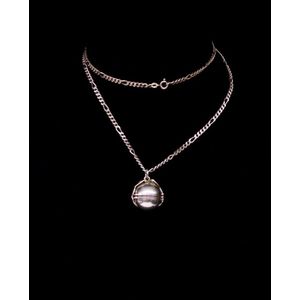
Taxco Sterling Silver Photo Ball Pendant with Figaro Chain
Sterling silver photo ball pendant on chain with accordion type hinged opening. Marked Taxco Raphael Mexico 925, 925 Italy to the figaro chain, approix ball size 20 mm closed, chain length 68 cm, weight 35 grams

Silver Ball & Foldable Photo Locket Set
A sterling silver ball photo locket, four consatina locket in silver Wt 10 grams

Rose Gold Locket Pendant with Seed Pearls and Chain
A c.1900 9ct. rose gold pendant locket on chain the oval pendant highlighted with seed pearls, a photo to each side, the circular link neck chain of length 42 cm. 8.3gm.

Victorian Diamond and Pearl Locket with Photo Frames
Victorian gold locket, of oval form, accented with diamonds and seed pearls, opening to reveal two photo frames, height 5.5 cm

Art Nouveau Gold Pendant with Blue Stone and Photo Frame
15ct gold Art Nouveau pendant, of pierced shaped form, with central photo frame, accented with blue stone, height 4.5 cm

Victorian Gold Mourning Locket with Blue Enamel Cross
A Victorian gold mourning locket, oval form, the front decorated with a blue enamel and seed pearl set cross, the interior with a two photos, tests as 14ct gold. Provenance: Estate collection.

Victorian Hair Locket in Engraved Gold Bezel
A Victorian mourning locket, oval black glass with hair lock framed by an engraved gold bezel.

Victorian Gold Mourning Locket with Baronet's Initials
A large an impressive Victorian gold mourning locket, the front decorated with a baronet's coronet set with four pearls above a large initial H, the interior set with a photo of Sir John Hanmer Baronet, to one side with woven hair to the other, unmarked…

Diamond and Sapphire Pendant Locket Necklace with Initial Engraving
18ct gold, diamond and sapphire pendant locket necklace, terminating on an oval hinged locket measuring approximately 65 x 35 mm opening to reveal a mirror and photograph well, the obverse engraved with an initial partially decorated with old-cut diamonds…

Enamel and Diamond Locket Necklace
18ct gold necklace and enamel and diamond-set miniature locket, terminating on a rectangular hinged locket measuring approximately 25 x 20 mm opening to reveal a triple photograph well, the obverse applied with an enamelled portrait of a woman facing…

Wilcannia Boating Club Locket with Portrait and Hair Lock
Australian Colonial locket, 18th yellow gold inscribed 'Wilcannia Boating Club, 28th August 1884, Scratch Fours Opening Regatta, Club Trophy Presented To J.T. Williamson, Stroke'. Interior of locket with photo portrait and lock of hair. 4 cm high, 16…

Victorian French Jet Cameo Locket with Classical Portrait
Victorian French jet cameo photo locket, the oval locket carved with classical portrait to cover

Victorian Shield Locket with Diamond
Late Victorian 9ct shield photo locket, set with single old mine cut diamond

Victorian 14ct Gold Dove Mourning Locket
Victorian micro mosaic mourning locket depicting a dove. Approx locket size ex bail 20 mm x 25 mm, Tests as 14ct gold in parts, total weight 8.4 grams

Gilded Bloodstone Locket with Engraved Back
A late 19th century gilded 9ct. yellow gold photo locket, oval form, the front with bloodstone panel, engraved back.

Rose Gold Locket with Victorian Essex Crystal Monogram
Victorian crystal and rose gold locket, with Essex crystal or reverse intaglio carved and painted monogram and date. Photograph to reverse approx width 18 mm


 Loading more...
Loading more...